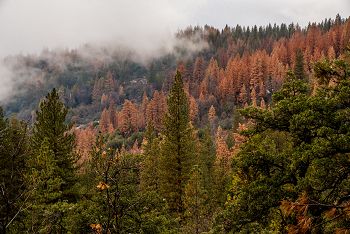Sustainability 2020
The CZOs presented the 2020 CZO Webinar Series to highlight research findings of CZOs and discuss the impact and relevancy of their findings on society and environmental sustainability.
2020 CZO Webinar Series on Sustainabilty
Watch | "How Climate and Geology Pre-Condition the Response of Upland Watersheds to Human Impacts"
Speaker: Roman DiBiase, PSU, Susquehanna Shale Hills CZO
Watch | “Predicting mountain-ecosystem response to disturbance through scaling subsurface water-storage capacity”
Speaker: Roger Bales, UC Merced, Southern Sierra CZO
Watch | “Critical Zone Evolution of the Central Lowlands: Glacial and Anthropogenic Legacies”
Speakers: Alison Anders, Qina Yan & Praveen Kumar, UIUC, IML CZO
Watch | “Coupled Root Exudate and Reactive Transport Modeling”
Speakers: Susana Roque-Malo, Jennifer Druhan & Praveen Kumar, UIUC, IML CZO
Watch | "Heraclitus and why you can't step into the same Critical Zone twice"
Speaker: Dan Richter, Duke U., Calhoun CZO
Watch | "The Dirt on Soil Sustainability"
Speaker: Jane Willenbring, Stanford U., Luquillo CZO
"How Climate and Geology Pre-Condition the Response of Upland Watersheds to Human Impacts"
The discharge of sediments and solutes from agricultural landscapes is a major environmental problem and can have dire consequences for downstream ecosystems. Managing this problem is complex because watersheds do not all respond similarly to agricultural practices. This talk focuses on a series of research questions targeting the concept of “landscape resilience,” which the authors refer to as the ability of a headwater landscape to function despite impact from a disturbance. Using examples from the Chesapeake Basin, authors pose the hypothesis that the geological history of a landscape pre-conditions its geomorphological and biogeochemical response to disturbance, in this case, agricultural activity. | Speaker: Roman DiBiase (Penn State University, Shale Hills CZO)
“Predicting mountain-ecosystem response to disturbance through scaling subsurface water-storage capacity”
The historical, widespread forest disturbance by wildfire and drought-induced tree mortality in the Sierra Nevada is accompanied by changes in the water balance through the amount of precipitation partitioned between evapotranspiration (ET) and runoff. In this webinar, Bales discusses the use of historical ET assessments and annual spatial patterns determined from multiple data sources in two densely forested watersheds in the Sierra Nevada to project changes in water balance from forest management, and to assess forest vulnerability to drought. Critical-zone research, when brought into the public realm, is central to providing the scientific basis for bringing stakeholders together to overcome barriers to restoration and more-sustainable management of these overstocked forests. | Speaker: Roger Bales (UC Merced, Southern Sierra CZO)
“Critical Zone Evolution of the Central Lowlands: Glacial and Anthropogenic Legacies”
In this webinar, speakers explain CZ evolution of the central lowlands landscape found at the Intensively Managed Landscapes CZO through the Quaternary period and into the Anthropocene where modern agricultural processes are rapidly altering the landscape seen today. Soil organic carbon (SOC) is going through rapid reorganization due to anthropogenic influences. Understanding how biogeochemical transformation and erosion‐induced SOC redistribution influence SOC profiles and stocks is critical to our food security and adaptation to climate change. Yan discusses a developed process‐based quasi 3‐D model that couples surface runoff, soil moisture dynamics, biogeochemical transformation, and landscape evolution. This model was applied to a sub catchment in Iowa to understand how natural forcing and farming practices affect the SOC dynamics in the critical zone. | Speakers: Alison Anders, Qina Yan and Praveen Kumar (University of Illinois at Urbana- Champaign, IML CZO)
“Coupled Root Exudate and Reactive Transport Modeling”
Root exudation is a universal process by which vegetation releases organic compounds into the soil. This process, as a strong driver of CZ biogeochemical cycling, directly links vegetation to both microbes and the soil. The role of root exudation is explored in a diverse range of processes across varying ecosystems, from nutrient cycling in corn and soybean fields to weathering of the regolith. Speakers present the novel modeling framework under development which exploits the complementary features of the root exudation model REWT (Root Exudation in Watershed-scale Transport) with the reactive transport model CrunchFlow. The intent with this research is to improve understanding of ecosystem resilience under future climate and to identify and take advantage of naturally occurring root-soil-microbe feedbacks in managed ecosystems. | Speakers: Susana Roque-Malo and Jennifer Druhan (University of Illinois at Urbana-Champaign, IML CZO)
"Heraclitus and why you can't step into the same Critical Zone twice"
Richter delves into a modern take based on philosopher Heraclitus’ statement, “You can’t step into the same river twice.” He discusses the traditional and contemporary interpretations of this statement and how it applies to the flux and turnover of constituents within the CZ observed at Calhoun CZO. | Speaker: Dan Richter (Duke University, Calhoun CZO)
"The Dirt on Soil Sustainability"
What does soil sustainability mean? Willenbring breaks down this question by discussing how fast soil is lost due to erosion and replaced by production from bedrock. Her research focuses on measuring and comparing resident times of cosmogenic nuclides, which are isotopes formed by interaction with cosmic rays, to determine the rates of soil erosion and production within the Luquillo CZO. | Speaker: Jane Willenbring (Stanford University, Luquillo CZO)
Explore Further

